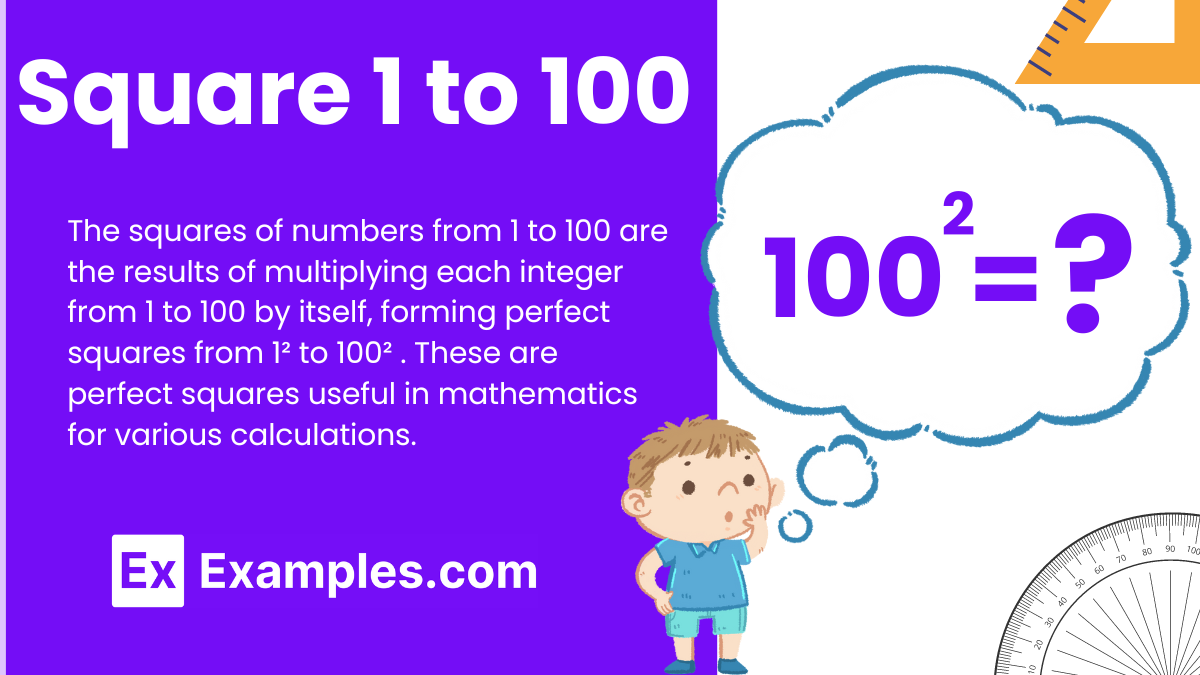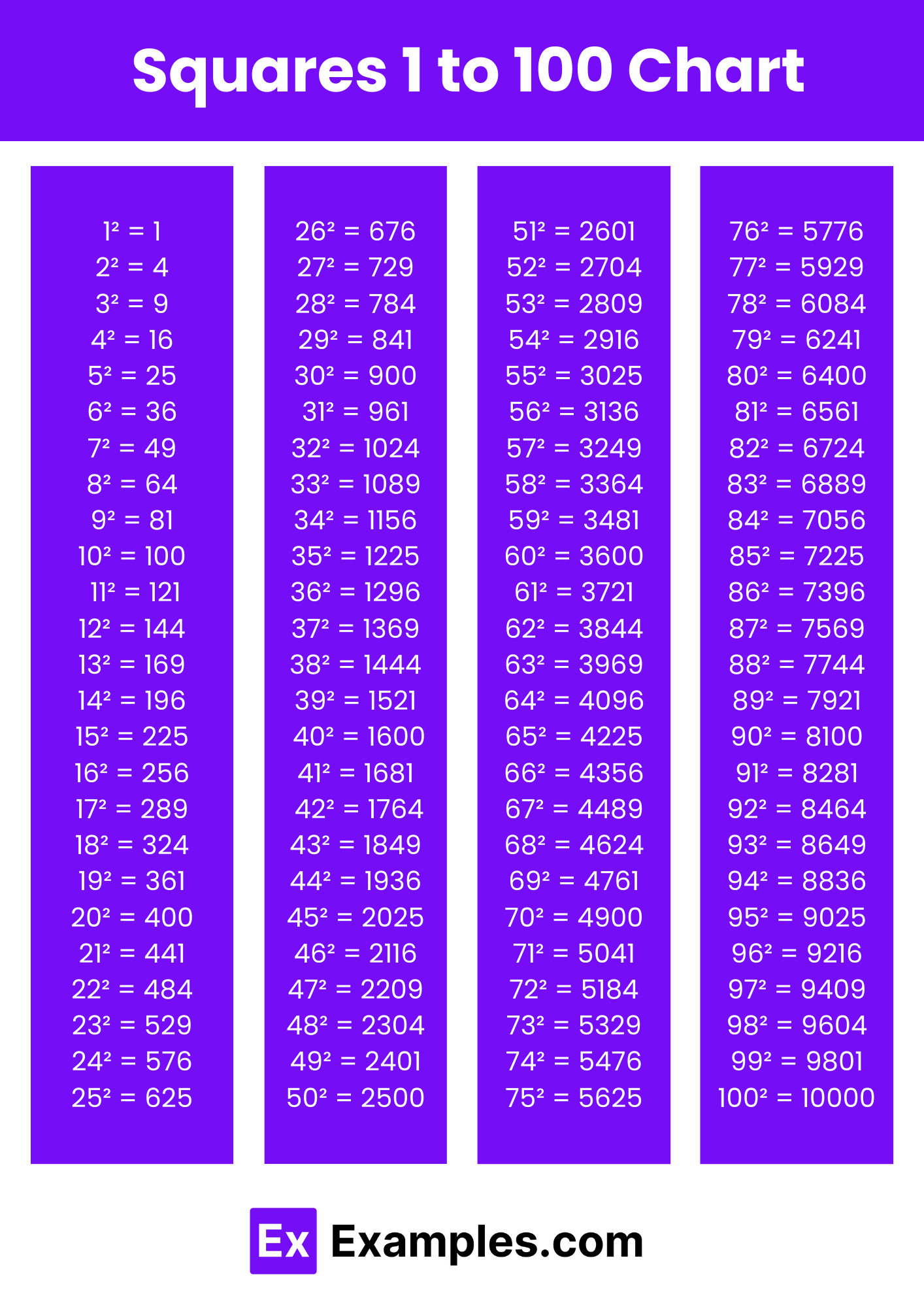Calculate the square of 6 by summing consecutive odd numbers starting from 1
26
30
36
42


Exploring squares from 1 to 100 unveils fundamental principles of mathematics, including algebra, number theory, and the concept of rational and irrational numbers. Squaring each integer illuminates the relationship between perfect squares and square roots, essential for understanding quadratic equations and algebraic expressions. This sequence of squares serves as a cornerstone in mathematical discourse, facilitating discussions on integers, irrationality, and the least square method in statistics. Understanding these squares enhances numerical literacy, providing a solid foundation for advanced mathematical concepts and real-world applications.
Download Squares 1 to 100 in PDF
The square of numbers from 1 to 100 refers to the result obtained by multiplying each integer in this range by itself, encompassing the set of perfect squares essential in mathematical analysis and applications.
Highest Value: 100² = 10000
Lowest Value: 1² = 1

Download Squares 1 to 100 in PDF
| List of All Squares from 1 to 100 | ||||
| 1² = 1 | 21² = 441 | 41² = 1681 | 61² = 3721 | 81² = 6561 |
| 2² = 4 | 22² = 484 | 42² = 1764 | 62² = 3844 | 82² = 6724 |
| 3² = 9 | 23² = 529 | 43² = 1849 | 63² = 3969 | 83² = 6889 |
| 4² = 16 | 24² = 576 | 44² = 1936 | 64² = 4096 | 84² = 7056 |
| 5² = 25 | 25² = 625 | 45² = 2025 | 652 = 4225 | 85² = 7225 |
| 6² = 36 | 26² = 6762 | 46² = 2116 | 66² = 4356 | 86² = 7396 |
| 7² = 49 | 27² = 729 | 47² = 2209 | 67² = 4489 | 87² = 7569 |
| 8² = 64 | 28² = 784 | 48² = 2304 | 68² = 4624 | 88² = 7744 |
| 9² = 81 | 29² = 841 | 49² = 2401 | 69² = 4761 | 89² = 7921 |
| 10² = 100 | 30² = 900 | 50² = 2500 | 70² = 4900 | 90² = 8100 |
| 11² = 121 | 31² = 961 | 51² = 2601 | 71² = 5041 | 91² = 8281 |
| 12² = 144 | 32² = 1024 | 52² = 2704 | 72² = 5184 | 92² = 8464 |
| 13² = 169 | 33² = 1089 | 53² = 2809 | 73² = 5329 | 93² = 8649 |
| 14² = 196 | 34² = 1156 | 54² = 2916 | 74² = 5476 | 94² = 8836 |
| 15² = 225 | 35² = 1225 | 55² = 3025 | 752 = 5625 | 95² = 9025 |
| 16² = 256 | 36² = 1296 | 56² = 3136 | 76² = 5776 | 96² = 9216 |
| 17² = 289 | 37² = 1369 | 57² = 3249 | 77² = 5929 | 97² = 9409 |
| 18² = 324 | 38² = 1444 | 58² = 3364 | 78² = 6084 | 98² = 9604 |
| 19² = 361 | 39² = 1521 | 59² = 3481 | 79² = 6241 | 99² = 9801 |
| 20² = 400 | 40² = 1600 | 60² = 3600 | 80² = 6400 | 100² = 10000 |
This table lists the squares of numbers from 1 to 100 in ascending order, illustrating the result of multiplying each integer by itself. It serves as a reference for understanding the quadratic growth pattern of square values within this range.
| 2² = 4 | 22² = 484 | 42² = 1764 | 62² = 3844 | 82² = 6724 |
| 4² = 16 | 24² = 576 | 44² = 1936 | 64² = 4096 | 84² = 7056 |
| 6² = 36 | 26² = 676 | 46² = 2116 | 66² = 4356 | 86² = 7396 |
| 8² = 64 | 28² = 784 | 48² = 2304 | 68² = 4624 | 88² = 7744 |
| 10² = 100 | 30² = 900 | 50² = 2500 | 70² = 4900 | 90² = 8100 |
| 12² = 144 | 32² = 1024 | 52² = 2704 | 72² = 5184 | 92² = 8464 |
| 14² = 196 | 34² = 1156 | 54² = 2916 | 74² = 5476 | 94² = 8836 |
| 16² = 256 | 36² = 1296 | 56² = 3136 | 76² = 5776 | 96² = 9216 |
| 18² = 324 | 38² = 1444 | 58² = 3364 | 78² = 6084 | 98² = 9604 |
| 20² = 400 | 40² = 1600 | 60² = 3600 | 80² = 6400 | 100² = 10000 |
This list presents the squares of numbers ending in 2, 4, 6, 8, and 0, showcasing a pattern where the last digit of each square follows a specific sequence. The squares are calculated by multiplying each number by itself, demonstrating the quadratic growth of square values.
| 1² = 1 | 21² = 441 | 41² = 1681 | 61² = 3721 | 81² = 6561 |
| 3² = 9 | 23² = 529 | 43² = 1849 | 63² = 3969 | 83² = 6889 |
| 5² = 25 | 25² = 625 | 45² = 2025 | 65² = 4225 | 85² = 7225 |
| 7² = 49 | 27² = 729 | 47² = 2209 | 67² = 4489 | 87² = 7569 |
| 9² = 81 | 29² = 841 | 49² = 2401 | 69² = 4761 | 89² = 7921 |
| 11² = 121 | 31² = 961 | 51² = 2601 | 71² = 5041 | 91² = 8281 |
| 13² = 169 | 33² = 1089 | 53² = 2809 | 73² = 5329 | 93² = 8649 |
| 15² = 225 | 35² = 1225 | 55² = 3025 | 75² = 5625 | 95² = 9025 |
| 17² = 289 | 37² = 1369 | 57² = 3249 | 77² = 5929 | 97² = 9409 |
| 192 = 361 | 39² = 1521 | 59² = 3481 | 79² = 6241 | 99² = 9801 |
This list showcases the squares of numbers from 1 to 99, emphasizing the pattern where the last digit of each square follows a specific sequence. Each square is calculated by multiplying its respective number by itself, illustrating the quadratic growth of square values.
To calculate the squares of numbers from 1 to 100, you can follow these steps:
Understand Squaring:
Start from 1 and Go Up to 100:
Use a Calculator for Efficiency:
Record Your Results:
Review the Pattern:
The squares of numbers from 1 to 100 are the results obtained by multiplying each integer in this range by itself. For example, the square of 4 is 16, and the square of 10 is 100.
The squares of numbers from 1 to 100 represent a sequence of integers resulting from multiplying each number by itself, with values ranging from 1 to 10,000. This sequence showcases a pattern of quadratic growth, essential in mathematics for algebraic operations, geometric calculations, and statistical analysis.
Several patterns emerge in the squares of numbers from 1 to 100, including the alternating pattern of the last digits (0, 1, 4, 9, 6, 5) and the quadratic growth of square values. These patterns are useful for mental calculations and recognizing relationships between numbers.
While some squares can be easily calculated mentally, using a calculator is often more efficient, especially for larger numbers. Organizing the calculations in a systematic way, such as grouping numbers or using shortcuts, can also streamline the process.
Knowledge of squares is essential in algebra for solving quadratic equations, factoring polynomials, and understanding properties of exponents. In number theory, squares are studied to explore relationships between integers, such as perfect squares and prime numbers.
Text prompt
Add Tone
10 Examples of Public speaking
20 Examples of Gas lighting
Calculate the square of 6 by summing consecutive odd numbers starting from 1
26
30
36
42
What is the square of 25 using the formula (a+b)² = a² + 2ab + b²? Let a = 20 and b = 5.
434
550
625
650
Calculate 9² using repeated addition.
81
86
90
100
What is 12²?
124
134
144
154
Calculate the square of 50 using direct multiplication.
2400
2500
2600
2700
Find the square of 7 using repeated addition.
45
47
49
51
Find the square of 11.
100
110
121
130
What is 45² using direct multiplication?
2025
2100
2200
2300
What is the square of 18?
324
336
348
360
What is 40²?
1400
1500
1600
1700
Before you leave, take our quick quiz to enhance your learning!

